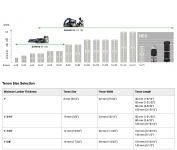Boski said:
The DF500 isn't getting much use and is near immaculate. ...
What's the general consensus on here for DF700 for larger furniture?
It's great, don't hesitate any longer.
OK, you probably want more, so here goes:
The DF700 was introduced after the DF500, and has a number of improvements from Festool:
1) There are 3 referencing paddles on each side of the bit, not just 1.
2) The paddles lock out of the way individually without tools.
3) The height block is calibrated to the center of the bits, not the DF500's crazy "thickness of stock into which the bit would be half-way" height block.
4) There are two depth stops so for corner joints (and the connector usage), you can set one for milling into the faces and one for deeper milling into the ends. Makes that too deep into the face mistake less likely.
5) It's got a real handle, you don't have to figure out how to best grip the body to apply smooth even pressure to plunge.
6) The base/bottom and screw holes are the same dimensionally, so anything that attaches to that (eg Big Foot) still works. The cross stops also work (need to flip the pin thingie around, but that's easy peasy).
On the downside, it's heavier and more expensive.
I bought the Seneca bit adapter to be able to run DF500 dominos. I've used it once for 6mm dominos and it was OK. I bought both the DF500 and DF700 domino assortments in systainers. Those DF500 dominos are so cute! But, for me anyway, special purposed.
OK, I've probably started a storm. The "general consensus" is to get/keep the DF500. But remember, that's coming from people building things out of sheet goods or 4/4 lumber at most. If you make kitchen cabinets for a living you want the DF500 (assuming you actually want to use dominos for those). If you work with plywood/mdf all the time you want the DF500. But, if you're building furniture (and I don't mean just bookcases), then you're probably working with thicker stock a lot of the time and so you really do want the DF700. Even a lot of indoor furniture uses 5/4 or 6/4, and with anything like a chair and you'll want something more substantial than the not even 1" tenon projection into the wood you get with the DF500. Like I said, those DF500s dominos are cute.
With the DF700, you can run any 8mm domino, just like the DF500. If you really need/want the 6mm for sheet goods then the Seneca adapter works pretty well as long as you don't plunge too quickly. If you do things like picture frames or need the 5mm and 4mm sizes, then you might be pushing it to wrastle the DF700 with those bits. I haven't tried the 5mm/4mm bits yet.
But, if you're doing chairs, beds, couches, especially if you work with solid wood instead of sheet goods, the DF700 shines. And the 6mm domino isn't a problem for when you use 4/4 stock or 18mm sheet goods.


